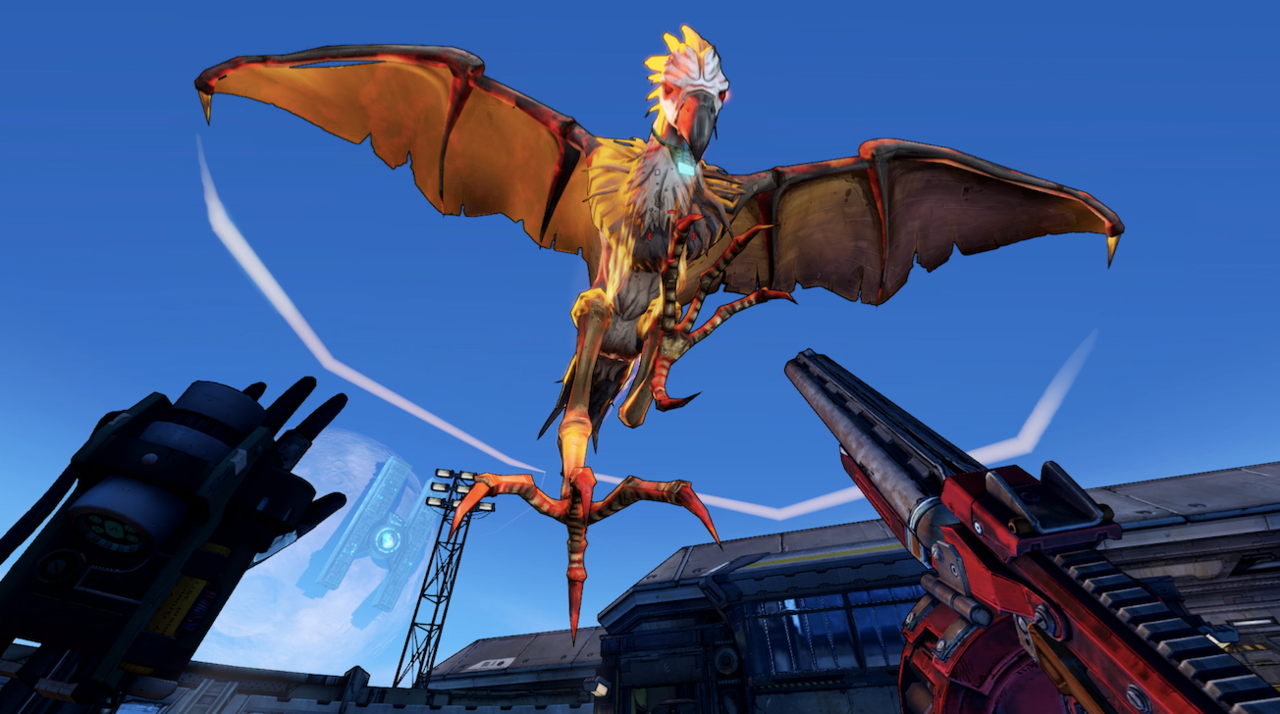Should You Play Borderlands 2 In VR?
For all its mechanical issues, there is one very crucial reason why Skyrim, another major game that got an after-the-fact VR port, worked so well: It was breathtaking to be in that world. There were dragons and dangers and perils, naturally, but there was also peace, serenity, beauty, and an undeniable sense of grandiosity. These are all things that, unless you’re specifically making a horror game, make a virtual experience worthwhile. The biggest problem, then, with porting Borderlands 2 to VR is that right from its first minutes, Pandora is such an ugly, cruel, obnoxious place that immersion works against it.
That’s the tip of the iceberg as far as Borderlands 2 VR goes, however. By and large, it’s still the same game, with all the problems it’s always had. Story-wise, every aspect of the game either actively insulting you or trying to kill you at every turn with little to no respite can get grating. Gameplay-wise, it is still very much the old MMO-inspired shooter it’s always been, where the goal is more about increasing your stats and collecting better loot than the sheer thrill of killing maniacal wastelanders ad nauseum. Even still, the game has its charms: the sheer variety of weaponry and enemies, the wild comic cel-shaded art style, and a sense of humor that, when it lands, lands big. These are the things that Borderlands 2 VR maintains.
Having said that, Gearbox giveth and Gearbox taketh away for this port. The big loss here is that co-op is entirely gone, which is the one thing that made the grind of Borderlands 2 tolerable. Borderlands 2 solo is a frustrating experience the deeper you go, and this exacerbates that problem. On top of that, Borderlands 2 VR is just Borderlands 2–as in, the Pre-Sequel and the DLC are nowhere to be found. Combine all that with the fact that the game’s cutscenes haven’t been rendered in VR, meaning frequent and jarring shifts to Theater Mode, which makes this feel more like a protracted experiment rather than a well-curated, definitive experience meant to stand on its own.
The feeling that the game is just throwing ideas about how Borderlands should operate in VR at the wall to see what sticks extends to the way it controls. There’s only two ways to control the game: the DualShock 4 or the PS Move controllers, which means yes, once again, the often-neglected PS Aim controller has gone ignored in a game that could have been better for its inclusion. Between the two, weirdly enough, the advantage goes to the DualShock, which is mostly using the same control scheme as The Handsome Collection, save for jump and crouch. The PS Move, on the other hand, is a convoluted mess of commands where the only button that adheres to logic is the trigger to fire your guns.
Movement is handled by holding down the Move button and tilting the left controller whichever way you want to move, which is fine for simple traversal, but Borderlands’ enemies are hectic and know how to use cover; a weapon’s accuracy has never been more crucial, and it’s the stat you find at acceptable levels in new guns the least. The DualShock scheme is superior here as well, with aiming handled entirely with the PSVR headset by itself instead of the controller, which surprisingly feels far more intuitive than aiming with your hand. Much of that has to do with how wonderfully comprehensive the options are in terms of customizing your VR experience to scale with your personal level of VR sea legs. If there’s any one thing Borderlands 2 VR gets 100% right, it’s this.
The one other major change to the game is a rather fundamental one: the addition of a slo-mo mechanic called BAMF Time that allows you to slow time to a crawl for a brief period. It’s balanced just well enough so that it doesn’t break the game, and it does make up for VR’s shortcomings, especially in the early, clumsy stage. More than this, it turns out to be just the tool the doctor ordered to deal with some of the more frustrating areas–read: any place where there’s Threshers involved–without having a rage-induced heart attack.
Thing is, even with the net positives, Borderlands 2 isn’t necessarily better with the PSVR involved. The things that make Borderlands appealing mostly boil down to the humor and the meticulous management of your arsenal, neither of which are easier or prettier in VR–Borderlands is still best experienced with the Handsome Collection, which also includes co-op and and hours hours more of Tiny Tina. The things Borderlands 2 in VR brings to the table are all things we’ve seen better executed elsewhere. Pandora ain’t no place for a hero. Even with slo-mo, and the ability to point and shoot with your own eyes and hands, it still isn’t.
Powered by WPeMatico








